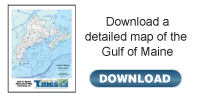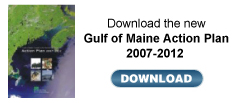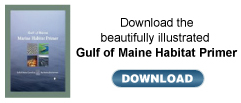Travelogue
Meeting whales on their terms in the Bay of Fundy
By Karen Finogle
The breaths come suddenly. Short bursts of moist air blown
urgently into the night sky. A mammalian geyser trades carbon
dioxide for oxygen before it slips beneath the surface. It’s
over in seconds. Perched on the edge of a cliff, at a campsite
50 feet (15 meters) above the ocean, I crane my head forward to
scan the murky darkness below. I wait…for a shimmering back
or barnacled head to break the surface. Nothing.
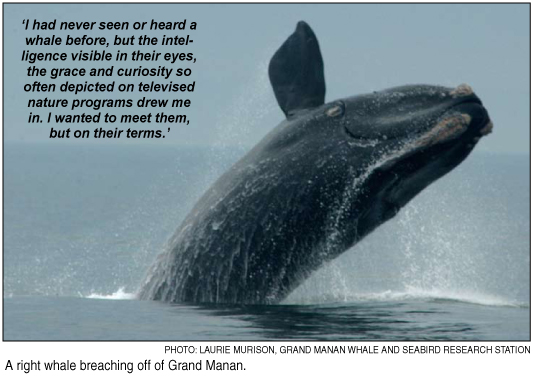
And then another blowhole sounds off. Twice this time. Another
follows minutes later. The whales surface in the shadows, avoiding
the single moonbeam that casts a carpet of light across the Bay
of Fundy. My chance to see these baleen feeders evaporates with
their invisible breaths.
Hearing them is its own magic. In a silence interrupted only
by the waves lapping against the rocks, these creatures surface
and exhale with voracity—as if they are on the verge of drowning.
In response, I quiet my own breathing and listen. My whole being
is tuned to their frequency, awaiting their missives.
My blubbery companions could be humpback or endangered North
Atlantic right whales, but they are likely finback or minke whales,
which are most often spotted from the shoreline. Members of all
four species spend the summer and fall months near Grand Manan,
a Canadian island in the Bay of Fundy that is 15 miles (24 kilometers)
long by almost seven miles (11 kilometers) wide.
Like much of the land that touches the Bay, Grand Manan has
some of the highest tides in the world, 27 to 30 feet high (8
to 9 meters), and they change every six hours. That’s the
secret behind what makes these waters such a four-star destination
for whales.
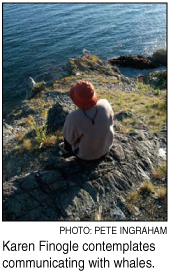 Approximately 100 billion tons of water is pushed in and out
of the Bay twice a day. This kinetic energy acts as a giant biological
mixer, churning up nutrients and bringing them to the surface
where phytoplankton—round, single-celled organisms that are
algae, bacteria or fungi—grow through photosynthesis. Phytoplankton
is the diet of zooplankton, tiny ocean animals that float at the
whim of ocean currents. And zooplankton is the food staple of
our baleen friends. Approximately 100 billion tons of water is pushed in and out
of the Bay twice a day. This kinetic energy acts as a giant biological
mixer, churning up nutrients and bringing them to the surface
where phytoplankton—round, single-celled organisms that are
algae, bacteria or fungi—grow through photosynthesis. Phytoplankton
is the diet of zooplankton, tiny ocean animals that float at the
whim of ocean currents. And zooplankton is the food staple of
our baleen friends.
I had begun my whale watch on the 90-minute ferry crossing
the Bay of Fundy from Blacks Harbour, New Brunswick, outside on
the deck until the stiff wind and pitch and roll of the ship sent
me inside to one of the vinyl, padded benches.
In the Bay, the endangered right whales, of which there are
only 300 to 350 left in the world, have the right of way. In 2003,
an international collaboration between shipping and oil companies,
scientists and the Canadian and U.S. governments led to the shifting
of shipping lanes four nautical miles east of established routes
in hopes of reducing collisions, which nearly always kill whales
if the vessel is large enough. Right whales, in particular, cannot
afford to lose even one animal if the species is to survive. The
shift diverts ships away from the primary feeding areas in the
Grand Manan Basin, an area of deep water between the island and
Nova Scotia, and has significantly reduced the number of whales
in direct exposure to vessels.
This year, that right-of-way will be extended, sort of. In
June, the Roseway Basin, an area 1,780 square nautical kilometers
southwest of Nova Scotia, will be designated as an area to be
avoided by container ships. Another example of international collaboration,
the new designation was adopted by the International Maritime
Organization last fall and will be in effect from June through
September each year. Unlike the Fundy regulation, this act is
voluntary, but shipping companies have historically been quick
to respond to such measures, and this particular act requires
only a minor route diversion.
The 50-degree Fahrenheit (10-degree Celsius) night air chills
me, and I must abandon my moonlit listening post on the northeastern
side of the island for the warmth of my sleeping bag. The tent
sits a mere 15 feet (4.5 meters) from the cliff edge, one of the
reasons I chose to come to the island and the Hole-in-the-Wall
Campground. I had never seen or heard a whale before, but the
intelligence visible in their eyes, the grace and curiosity so
often depicted on televised nature programs drew me in. I wanted
to meet them, but on their terms.
With the advent of daylight, I am back scanning the ocean water,
waiting for the whales to move by, on their way to floating banquets
of zooplankton. Every wave that rises and breaks offshore tricks
me into looking closer, but Gray seals are my closest companions.
They are Neptune’s Labrador Retrievers, spinning and twirling
in the water, mimicking the joy their terrestrial cousins find
in rolling in the grass. They dive and surface in the fishing
weir that stands near the cliff walls–a primitive-looking,
kidney-shaped herring trap used by bands of Passamaquody and Mik’maq.
Seals seem adept at navigating the entrance to the stake and
twine net structures that stand like sentries around Grand Manan;
the tall, thin poles driven in the ocean floor jut out of the
water, visible even at high tide. I watch as a seal’s head
bobs on the outside of the net, ducks, and then resurfaces inside
only minutes later.
Once herring enters a weir, they follow the path of the netting,
the curved shape of which continuously directs the fish away from
the entrance. It can also confuse harbor porpoises, and even whales.
In one year, there were more than 300 porpoises caught in the
weirs around Grand Manan. Most years, about 15 to 30 get trapped.
Occasionally, minke whales, and sometimes humpback and right whales,
swim through the opening and then become confused; they have known
no such confinement in the ocean and cannot negotiate an exit.
Luckily, the Grand Manan Whale and Seabird Research Station, a
research organization established in 1981, has been working with
weir fishermen for several years to develop successful techniques
that free both porpoises and whales safely.
It’s a more difficult scenario in other parts of the ocean
where other types of fixed fishing gear provide invisible barriers.
Through photographic documentation, 75 percent of right whale
and humpback whale populations have scars from entanglements.
Some whales break free but carry fishing line wrapped around their
fins, tails or baleens. If tight enough, the lines can saw through
flesh and expose the whales to infection and possible death.
Entanglement and collision are the two biggest risks to right
whales currently, and the Grand Manan Whale and Seabird Research
Station, as well as several other organizations, is continuously
working to find new avenues of communication and collaboration
with government agencies and private industry to identify ways
to reduce these threats.
My last night on Grand Manan, I again scramble to the cliff
as the moon begins to rise on the eastern edge of the Bay of Fundy.
It is quiet except for the white noise of water against rock and
the occasional laughter from nearby campers. I wait for the whales
to return, for the final breaths or calls that will include me
in their community, if only for a moment. I sit patiently as my
muscles grow stiff. Nothing but the sound of surf reaches my ears.
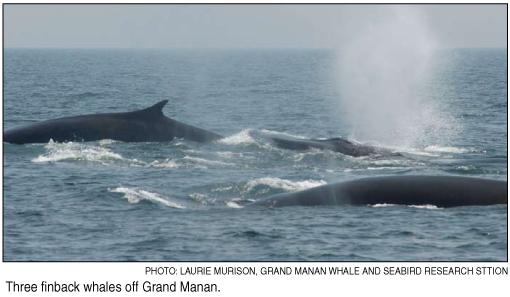
Underwater, somewhere else, they are probably calling to each
other. They are social creatures that rely heavily upon communication,
and hearing is perhaps their most important sense. The Bay, the
entire ocean really, has been getting louder. Increased shipping
traffic, blasting, harbor dredging, fishing, and even whale watch
tours all add noise to the ocean. And the Bay of Fundy is already
a naturally noisy area, where the tides alone can cause a whale
to raise its voice.
If only I could shout down to them, my voice penetrating the
water and riding the currents until it reached their ears. What
would I say? Would I apologize for all the other noise, for the
clutter we’ve added to their saltwater home? Would I stutter
and stumble, the awkward visitor at a family gathering?
I think I would simply start with a “hello” and listen
to what they had to say; the sound of their breathing has already
taught me so much.
Karen Finogle, a free-lance writer and senior editor at
AMC Outdoors, lives in Durham, New Hampshire.
|






